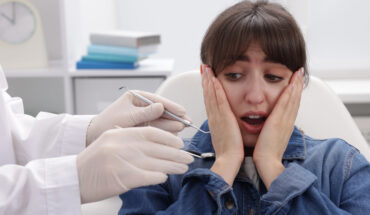
Sometimes in fact dentists sue their patients. Aggravated damages and legal costs can be awarded to practitioners from former patients for defamatory online reviews. Should they be found to have successfully caused immeasurable damage to reputation and business, and negatively impacted the emotional, psychological and physical wellbeing of the clinician, the resultant court judgment could feel like a punch in the mouth.
Somewhere in the vicinity of 100 000 people will read a review. It also has a grapevine effect where its statements spread beyond those who’ve actually seen it.
“Word of mouth.” About a dentist. When you’re mouthing off. There’s something in that.
If downturns in average weekly page views and new patient referrals can be proven in the aftermath of your negative review, a Beak may very well make you put your money where your mouth is.
The one that needed all that dental work.
Credibility is so vital to any dental clinic that correlations between patient demographics and patient satisfaction can be analysed and assessed using logistic regression analysis and calculated adjusted odds ratio.
Although patient satisfaction has been studied in the context of traditional medicine, patient satisfaction with dentists has received only minor attention. A 10-item, psychometric Dental Visit Satisfaction Scale was designed to evaluate the patient satisfaction of a specific visit. It provides three subscales: Information-Communication; Understanding-Acceptance; and Technical Competence – as well as an overall measure of contentment.
Women report a higher satisfaction rate in the cleanliness and neatness of a waiting room, and significant differences are found with making an appointment, and the cost of treatment. Patients with high incomes are less satisfied in terms of booking a time, and more satisfied with the treatment and cost than those of lower income. Dissatisfaction is significantly and more frequently found among younger age groups who had avoided
or delayed making a dental appointment because of the cost.
Seems obvious, really: on average, financially secure older people, generally with dental insurance, are more pleased than a struggling student during, and after their trip to the dentist. That they’re not so happy when making the appointment is anybody’s guess. Could be the necessity to change other plans in order to secure the slot. Were John Lydgate to dine with a somewhat puzzled dentist, no doubt he’d mention that you can’t please all of the people all of the time, recite his own Diet and Doctrine for the Pestilence, eat something light and take himself off to bed.
Being too early by 600 years still makes Lydgate a good dinner companion for someone who’ll be using dental implements at 8.30am. Sharp.
Dentists in Sydney operate in a highly litigious city and one principle of law relating to dental malpractice was ‘loss of chance’.
For a patient to win a malpractice suit against their dentist, their legal representative primarily has to prove two things: negligence, and causation.
That is, that their dentist failed to show duty of care, and that harm, injury or suffering was the result of this professional disregard. If either negligence or causation can’t be legally quantified the case will likely fail.
So, if the patient has an injury but their lawyer cannot show that the dentist acted negligently, then there is no case. Likewise, if it cannot be shown that the cause of that negligence was injury, then again the malpractice case is unlikely to succeed.
The level to which the patient’s lawyers must show that the dentist’s inattentiveness and unprofessionalism was the cause is based on the balance of probability, and therefore doesn’t have to be 100%.
So even if a dentist’s laxity or academic ignorance is established as 51% of the basis of a patient’s injury, it’s probable the patient will win the case and appropriate compensation awarded.
‘Loss of chance’ heightened the risk of legal action. It gave patients the right to sue for having lost the chance of a better outcome; meaning that no injury need ever have occurred, only that the patient’s belief is that the outcome could have been better. An example would be a person under care deciding that their implants, crowns or veneers looked wrong and must have been incorrectly fitted, even if they hadn’t been.
All that changed in 2010. In five separate, but unanimous judgments, the Justices of the High Court of Australia held that the law of negligence does not permit an action for recovery when the damage claimed can only be characterised as “the loss of a chance of a better outcome.”
The Court held that the rule requiring proof of damage on the balance of probabilities represents a striking by the law of a balance between the competing interests of the parties. The substitution of the loss of the chance as actionable damage represents a shift in the balance towards claimants by replacing notions of probabilities with notions of possibilities. Any such fundamental change in policy, it was held, is more appropriately the domain of Parliament.
A collective sigh of relief from the dental fraternity could be heard over all the flossing because generally, to take the matter to court, you don’t just sue your dentist – you put them out of business.
Which may be the outcome of a huge legal case against Invisalign.
This 36-page class action alleges that in 2017, when its convolution of intellectual property patents faced expiration, Invisalign engaged in a scheme to “foreclose competition” in the linked markets of aligners and hand-held digital intraoral scanners.
Align, the parent company, has for years enjoyed “more than 80 percent” of the plastic aligners market, enjoyed consistent, durable profit margins, and wielded intellectual property claims to protect its position.
According to the lawsuit, it has frequently engaged in patent infringement lawsuits against potential competitors, charged high prices and reaped significant profits from Invisalign because the product has been protected by “a thicket of hundreds of patents” wielded “aggressively” by the company to preserve the alleged monopoly.
The action represents:
“All persons or entities in the United States that purchased, paid and/or provided reimbursement for some or all of the purchase price for Invisalign Aligners acquired for personal use during the period beginning March 15, 2015 until such time as the anticompetitive conduct alleged herein has ceased (the ‘Class Period’).”
Accordingly, Invisalign is braced.




